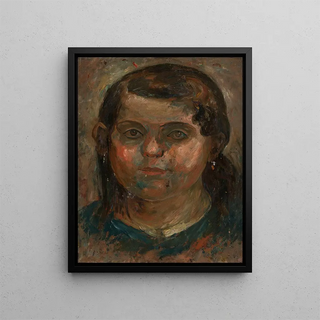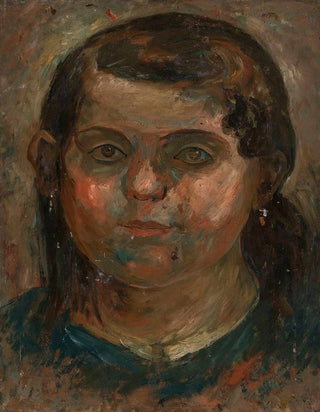Art print | Head of a Little Girl in a Blue Dress - Tadeusz Makowski


View from behind

Frame (optional)
Art print Tête d'une petite fille en robe bleue - Tadeusz Makowski – Captivating introduction
The "Tête d'une petite fille en robe bleue" by Tadeusz Makowski is a work that transcends a simple portrait to evoke a profound intimacy. This painting, through its subject and execution, captures the very essence of childhood, a theme dear to the artist. The little girl, with her innocent gaze and dreamy expression, seems to invite us to explore the twists and turns of her imagination. The work, both touching and mysterious, immerses us in a universe where childhood naivety blends with a certain melancholy, a duality that Makowski masterfully translates through his brushstrokes.
Style and uniqueness of the work
Tadeusz Makowski's style is distinguished by an approach that is both figurative and expressive. In this piece, the artist uses soft colors and rounded shapes to create a soothing atmosphere. The blue of the little girl's dress is not just a color but a symbol of tranquility and serenity. The delicate nuances that compose her face and features enhance this impression of gentleness. Makowski manages to capture light in a unique way, illuminating the child's face with an almost ethereal glow. This lighting technique highlights emotions, making the viewer a confidant of this fleeting moment. The composition, though simple, reveals a psychological depth that encourages contemplation and reflection.
The artist and his influence
Tadeusz Makowski, born in Poland and having developed within the French artistic scene, knew how to blend influences from his origins with those of his environment. His academic training, coupled with his experience in the arts world, allowed him to develop a unique style that reflects both tradition and modernity. Makowski was influenced by the Post-Impressionist movement, but he also knew how to diverge from conventions to create a deeply personal work. His portraits of children, such as this one, testify to his interest in child psychology and the representation of innocence. By exploring themes such as solitude and rêverie, he managed to touch generations of viewers, leaving an imprint.

Matte finish

View from behind

Frame (optional)
Art print Tête d'une petite fille en robe bleue - Tadeusz Makowski – Captivating introduction
The "Tête d'une petite fille en robe bleue" by Tadeusz Makowski is a work that transcends a simple portrait to evoke a profound intimacy. This painting, through its subject and execution, captures the very essence of childhood, a theme dear to the artist. The little girl, with her innocent gaze and dreamy expression, seems to invite us to explore the twists and turns of her imagination. The work, both touching and mysterious, immerses us in a universe where childhood naivety blends with a certain melancholy, a duality that Makowski masterfully translates through his brushstrokes.
Style and uniqueness of the work
Tadeusz Makowski's style is distinguished by an approach that is both figurative and expressive. In this piece, the artist uses soft colors and rounded shapes to create a soothing atmosphere. The blue of the little girl's dress is not just a color but a symbol of tranquility and serenity. The delicate nuances that compose her face and features enhance this impression of gentleness. Makowski manages to capture light in a unique way, illuminating the child's face with an almost ethereal glow. This lighting technique highlights emotions, making the viewer a confidant of this fleeting moment. The composition, though simple, reveals a psychological depth that encourages contemplation and reflection.
The artist and his influence
Tadeusz Makowski, born in Poland and having developed within the French artistic scene, knew how to blend influences from his origins with those of his environment. His academic training, coupled with his experience in the arts world, allowed him to develop a unique style that reflects both tradition and modernity. Makowski was influenced by the Post-Impressionist movement, but he also knew how to diverge from conventions to create a deeply personal work. His portraits of children, such as this one, testify to his interest in child psychology and the representation of innocence. By exploring themes such as solitude and rêverie, he managed to touch generations of viewers, leaving an imprint.






